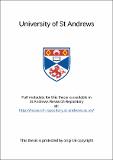Files in this item
Flow-dependent restructuring of the intermediate filament cytoskeleton and activation of NF-κB in cultured endothelial cells
Item metadata
| dc.contributor.author | Beers, Catherine | en |
| dc.coverage.spatial | 218p | en |
| dc.date.accessioned | 2021-04-08T08:59:36Z | |
| dc.date.available | 2021-04-08T08:59:36Z | |
| dc.date.issued | 2002 | |
| dc.identifier.uri | https://hdl.handle.net/10023/21954 | |
| dc.description.abstract | Endothelial cells are profoundly influenced by shear stresses associated with blood flow. A parallel plate chamber was used to study the effects of flow on (i) the morphology of the intermediate filament cytoskeleton; and (ii) the activation of an inducible nuclear transcription factor, NF-KB/Rel, in cultured human and bovine endothelial cells. The experiments described in Part One show that the distribution of intermediate filaments in static cultures is dramatically altered when cells become confluent. Immunostaining with antibody to vimentin showed that the diffuse meshwork of fine intermediate filaments characteristic of sub-confluent cells is reconfigured, forming a network dominated by a prominent 'ring' of intermediate filaments that surrounds the nucleus. The transition between the two states is triggered by the formation of cell-cell contacts. Immunoblots of whole cell lysates showed a time-dependent increase in vimentin expression and a simultaneous down-regulation of both actin and tubulin. The effect of exposing confluent and sub-confluent cultures to flow was therefore quite different. However, in both circumstances, some cells were seen to respond more rapidly than others and were affected to a much greater extent. This heterogeneity is attributed to spatial gradients of shear stress caused by irregularities in cell surface topography. The distribution of the intermediate filament-associated protein (IFAP) plectin was also investigated. Immunostaining using a monoclonal antibody (417D) to plectin showed that the protein is associated with the intermediate filament network. However, the staining was not uniform and the intensity was greatest on the basal cell surface, in the form of discrete 'streaks', a pattern very similar to that seen using antibodies to focal adhesion proteins. Studies have since shown that the tips of actin stress fibres and vimentin co-localise with plectin 'streaks', and with staining for the αᵥβ₃ integrin and the α4 sub unit of laminin. These so-called vimentin-associated matrix adhesions (VMA) serve to anchor both actin stress fibres and vimentin to the extracellular matrix, with plectin possibly acting as a cytoskeletal 'linker' protein. Part Two describes the results of experiments on the activation of NF-kB by flow. Cells were grown on cover slips or on glass microscope slides and then subjected to steady laminar flow. Indirect immunofluoresence was used to monitor nuclear translocation of the p65 sub-unit in endothelial cells over-expressing either wild type or catalytically inactive mutant forms of putative 'upstream' kinases (including IKK1, IKK2 and NIK). Endogenous IKK1 and DCK2 activities were determined by measuring ³²P incorporation into a GST-IKBα fusion protein substrate. Transcriptional activity of NF-kB was quantified by means of a Con A Luciferase reporter gene, driven by a 3kB enhancer element. A 19-fold increase in reporter activity confirmed that NF-kB induced by flow is transcriptionally active. Immunoblots of whole cell extracts were used to investigate the time course of the degradation of NF-kB inhibitor proteins (IkBα, IkBβ₁ and p105). The results show that flow rapidly activates IKK1 and IKK2 and transiently degrades IkBα and IkBβ₁, but not p105. Nuclear translocation of p65 is induced by flow in wild type cells, and also in cells over-expressing wild type IKK1, IKK2 and NIK but it is prevented in cells transfected with kinase-inactive mutants. These results show that IKK1, IKK2 and NIK are essential components of the signalling pathway activated by flow. | en |
| dc.language.iso | en | en |
| dc.publisher | University of St Andrews | en |
| dc.subject.lcc | QH607.B4 | |
| dc.subject.lcsh | Cell differentiation | en |
| dc.subject.lcsh | NF-kappa B (DNA-binding protein) | en |
| dc.title | Flow-dependent restructuring of the intermediate filament cytoskeleton and activation of NF-κB in cultured endothelial cells | en |
| dc.type | Thesis | en |
| dc.type.qualificationlevel | Doctoral | en |
| dc.type.qualificationname | PhD Doctor of Philosopy | en |
| dc.publisher.institution | The University of St Andrews | en |
This item appears in the following Collection(s)
Items in the St Andrews Research Repository are protected by copyright, with all rights reserved, unless otherwise indicated.

